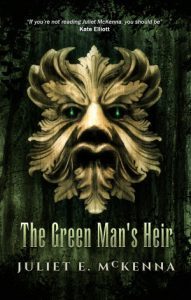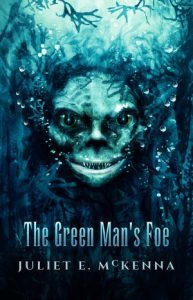Relationships with myth, old and new – Juliet E McKenna
Recently I’ve revisited myths that I haven’t thought about since I was a kid. That’s when I was working my way through school and local library shelves where folklore, fantasy and history were intermingled and often overlapped. Going back to these books and stories is one of the most rewarding aspects of writing my current contemporary fantasy series, where Dan Mackmain’s life is complicated by encounters with the supernatural, where the Green Man may or may not lend a hand.
So I’ve been thinking about our relationships with myth. At the most fundamental level, these stories are an attempt to make sense of the world around us. It’s a universal human impulse. Every culture as far back as we know has had gods and goddesses of thunder, of the harvest, of love, death and far, far more. Myths tell of interactions between humanity and the divine, often validating rituals to give thanks, to seek favour or avert disaster. On a more personal, more local level, tales of supernatural dangers lurking in woods and ponds have warned countless generations of children against straying into peril. Over time, these stories have been retold and reworked to reflect different times and concerns, as we see in the ceaseless retellings of Robin Hood and King Arthur up to and including modern film and TV.
This tells me any convincing secondary world in fantasy fiction will need its own myths. However simply appropriating an existing collection of such stories will rarely, if ever, succeed. Instead, fantasy authors need to take a good, long look at the folk tales we know, and their origins. We must analyse the relationships between these stories and the people who have told them, as well as with the lands where they live. Folklore is always deeply rooted in the lands where the people whose culture it is part of live; in what they long for and what they fear. Northern worlds of the dead are cold and dark while hells in hotter climates are lands of inescapable heat and searing thirst. The realm of the blessed is over the sea for those who live on the coast. Monsters lurk in the mountains for those who live in the valleys.
Add to that, folk tales rarely offer a fully-fledged plot, and those that do, such as famous ballads, are so well-known that it’s very hard indeed for an author to do anything sufficiently novel to be worthwhile. It’s not impossible, of course. We can all think of writers who’ve succeeded in bringing something new to Tam Lin – but they are few and far between. The far greater value of myths as a resource for a writer is the creatures and incidents they offer as a spur to the imagination. We can take these strands and weave something new that at the same time, offers the archetypes and other familiar elements that a reader can connect with. Two writers who do this with outstanding success are Alan Garner and Terry Pratchett.
Crucially, both Garner and Pratchett understand the uncompromising nature of myth. The more we look beyond the Disneyfication of folklore, the more we will encounter harsh, even horrifying stories. Take a look at the original Brothers Grimm, and it’s clear it’s a grave mistake to think of fairy tales as pretty stories for children. We have the Victorians to thank for this prejudice, by and large, as they sought to explain the world through science and rational means, disdaining ‘superstition’. Fairies and other supernatural creatures were downsized and sanitized, and the foundational role of these stories in great works of literature from Aeschylus to Shakespeare, and through to the modern day has been erased. We need to guard against this misconception, and not just to save fantasy writers from that well-meant but infuriating question, “have you ever thought about writing a book for adults?”

Alas, a great many myths have been lost, not least thanks to this prejudice. Modern conceptions of the Green Man, of Herne the Hunter, and of the Maiden, the Mother and the Crone don’t go back nearly as far as you might think. That we have these ideas and other local stories at all is often thanks to Victorian and Edwardian folklorists who realised that stories that were no longer retold would be lost if they weren’t recorded. This fading away of fable is still going on. If like me, you’re in your fifties, you’ll know what I mean if I mention “the Marie Celeste”. Go and ask a teen or twenty-something. You’ll get blank looks from most of that generation.
Folklore isn’t something settled and static. Figures like the Green Man, Herne the Hunter, and various personifications of the Moon as goddess frequently feature in modern paganism. These new belief systems and evolving practises stem from the same universal impulse as those very first myths our heritage of story began with: the wish to make sense of this universe, our place within it, and our relationship with the intangible. This may be of no interest or relevance to you personally, but please don’t think it means we can safely dismiss an understanding of folklore as a fringe or an academic pursuit.

We need to be aware that modern mythmaking is also going on around us on social media these days. This enduring and universal urge to make sense of the world can make people susceptible to conspiracy theories. When people with malicious or selfish intent craft their interpretations of current events and politics with an understanding of the ways in which stories work, they can manipulate public opinion with worrying ease and worse results. Take a look at politics in the UK and the US and it’s not hard to see how urban myths, partisan versions of history, and toxic takes on ‘what everybody knows’ have been used and abused to skew election outcomes.
So it shouldn’t come as any surprise to find that learning to look below the surface of what you’ve been told is emerging as a theme in a lot of current fantasy and science fiction. Who better to unpick the uses and abuses of stories than those who create them? Who better to find ways to push back at cynical misinformation that those used to reading between the lines? As readers and writers alike, we are playing our part in this ever-evolving relationship with myth.
Juliet E McKenna is a British fantasy author living in the Cotswolds, UK. Loving history, myth and other worlds since she first learned to read, she has written fifteen epic fantasy novels so far. Her debut, The Thief’s Gamble, began The Tales of Einarinn in 1999, followed by The Aldabreshin Compass sequence, The Chronicles of the Lescari Revolution and The Hadrumal Crisis trilogies. In association with Wizard’s Tower Press, she’s re-issued her early backlist as well as publishing original short story collections and contemporary fantasy novels rooted in British folklore. The series so far is The Green Man’s Heir, The Green Man’s Foe and The Green Man’s Silence. She writes diverse shorter fiction, enjoying forays into dark fantasy, steampunk and SF.
Visit julietemckenna.com or follow @JulietEMcKenna on Twitter.
Please Feel Free to Share:









